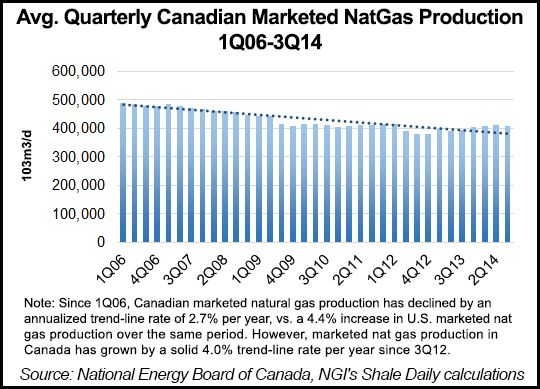E&P | NGI All News Access | NGI The Weekly Gas Market Report
Canadian Shale Development Too New to Predict Eventual Production, Say Analysts
Infant Canadian shale development is still too new to predict eventual production by spreading horizontal drilling and hydraulic fracturing, say elder Alberta earth science and engineering professionals.

Brad Hayes, president of Petrel Robertson Consulting Ltd., suggests taking popular astronomical shale oil and natural gas forecasts with the proverbial grain of salt. “There is huge variability,” agrees Sproule Associates vice-president Cameron Six.
Hayes and Six emphasized unknowns when they reported results of a pioneer effort to add economic focus into geological visions of national subterranean wealth. Professional peers and energy entrepreneurs filled an auditorium in the industry capital of Calgary this week for the event, which was held by the Canadian Society for Unconventional Resources and the Alberta government.
Canadian shale deposits are still geological and technical frontiers, said Six. “Companies are continuously pushing the edge out into lower quality rock.”
Even in a half-dozen established drilling “plays” or zones where enough horizontal and fracked wells are producing to enable expert guesswork, extreme variability of results render forecasts sketchy at best, Six observed.
The best-known targets in Alberta, British Columbia, Saskatchewan and Manitoba contain an agreed “original oil in place” volume — or OOIP natural endowment — of 194 billion barrels of gas-liquids and “tight” crude, said Six.
But the group’s “estimated ultimate recovery” or EUR, as shown by well results to date, covers a wide waterfront of 3.3-25.9 billion barrels. Performances at pumping out projected contents are in an unpredictable range of 1-20%.
Success varies widely not only between regions within U.S. state-sized formations such as the 130,000-square-kilometer (52,000-square-mile) Montney and 140,000-square-kilometer (56,000-square-mile) Duvernay — but also between the regions, said Six.
Initial production rates of Montney wells, for instance, vary from 50 to 600 b/d, reported Six. Productivity declines over the first year of well lifespans run as high as 65%.
From the viewpoint of specialists in petroleum engineering and auditing oil and gas company assets, estimated contents of Canadian shale deposits remain only potential resources. “They’re not reserves,” said Six. “There’s no confidence.”
Hayes agreed that while “the numbers are huge” in broad-brush shale portraits painted by Canadian federal and provincial government earth sciences research agencies, “it’s too early to add them up.”
Hayes reported forecasts of undeveloped resources vary widely even for smaller shale deposits that have a long history of being drilled through for wells into conventional pools that yield oil and gas naturally from big rock pores and open flow channels.
Shale “tight oil” projections for the Swan Hills area northwest of the Alberta capital of Edmonton, for instance, range from 2.5 billion to 7.5 billion barrels.
Estimates for the Montney, which carpets northwestern Alberta and northeastern B.C., are 80 billion to 141.5 billion barrels. In the Duvernay, the current exploration hot spot, projections range from 44 billion to 83 billion barrels.
“There needs to be some more work done,” said Hayes.
The only sure thing about Canadian production with horizontal drilling and fracking is that high oil prices to date stimulated a rash of growth from multiple formations, says the biggest pipeline construction application yet to the National Energy Board (NEB).
TransCanada Corp., while making no predictions, highlights the Canadian shale record to date in its application for its CDN$12-billion (US$10.7-billion) Energy East partial conversion and extension of its gas Mainline to 1.1 million b/d of oil service.
From almost zero when Canadians started importing the new technology in 2007, shale liquids production grew to almost 350,000 b/d as of year-end 2013 in the three western provinces crossed by the Mainline: Alberta, Saskatchewan and Manitoba.
The Energy East application portrays the Canadian outlook as reasonably foreseeable growth from the factory-like northern Alberta oil sands plus potentially lively production additions from the more adventurous shale formations.
“The development of tight oil resources in the Western Canadian Sedimentary Basin has not occurred at nearly the same pace as in the US, but production has grown almost 350% between 2010 and 2013,” observes TransCanada.
On top of East Coast tanker outlets for Alberta bitumen, the mammoth eastbound pipeline scheme promises an overseas escape route from price-wounding collisions on North American oil markets with U.S. shale supplies. TransCanada says, “The [Energy East] project opens access to new light crude oil markets, both domestic and international, that can absorb Canadian light crude released from the traditional U.S. markets.”
© 2024 Natural Gas Intelligence. All rights reserved.
ISSN © 2577-9877 | ISSN © 1532-1266 | ISSN © 2158-8023 |
